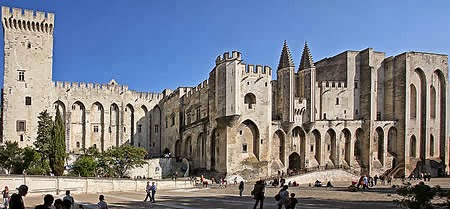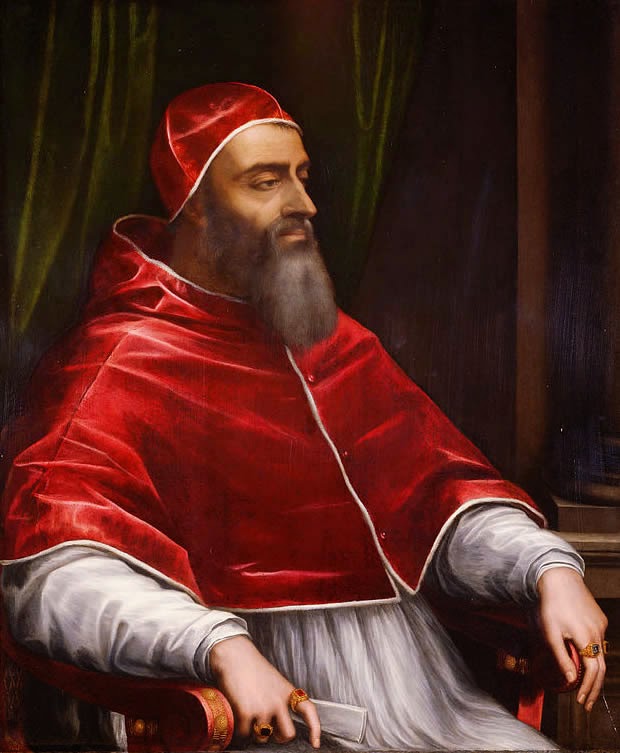 |
| Avignonese Papacy |
The Avignonese papacy (1304–78) and the Great Schism (1378–1414) are regarded as two of the most dramatic events in the history of Christianity that further undermined and diminished the prestige of the papacy and the authority of the Western Latin Church.
The first penggalan refers to the nearly century-long pontificate of eight popes, who from the beginning of the 14th century until 1378 ruled the Christian world from the French town of Avignon, being held captive by Philip IV the Fair; because of its forced nature, the Avignonese papacy is also called the Avignonese Captivity, or Exile.
Historians attribute the cause of the Avignonese Exile of the papacy to the earlier conflict between Pope Boniface VIII and the young French king Philip the Fair in the preceding century, when the king and the pope were struggling to proclaim their rule over Europe. In the center of the conflict stood new military taxes the king levied on French monasteries, requiring new subsidies to fight his wars with the English.
Boniface rejected the king’s claims for financing his army on account of the church in the bull Clericis laicos from 1290 and later paid for his stubbornness with his own life, literally terrified to death by the king’s chancellor William of Nogaret.
Boniface’s direct successor, Benedict XI (1303–04), did not live long enough to pacify the spirits, supposedly having been poisoned by an unidentified monk; a new pope, old and gravely ill, Bertrand de Got, who assumed the name Clement V, led the papacy into exile.
Residing in France at the time of his election, weakened by what was likely cancer, and discouraged by the fate of his predecessor, Clement V capitulated to Philip’s demands that he should be crowned at Lyon. He established the tradition of the Avignonese papacy, never setting foot in the ancient city of Rome.
 |
| Pope John XXII |
Throughout the 14th century the Avignonese papacy was continuously showing signs of decline of papal authority, which was becoming increasingly undermined by the feudal monarchy. In 1312 the papacy surrendered to the will of Philp IV and dismissed the Order of the Templars, famous for its wealth, with thousands of its members accused of heresy, witchcraft, and sodomy and all its treasures confiscated by the crown.
The fiscal oppression of the curia (chiefly through control over the sale of benefices and indulgences but also over tithes and annates) became more amplified during the Avignonese papacy, despite the heavy French presence in the College of Cardinals (seven out of eight Avignonese popes and almost all of the important cardinals were Frenchmen by the middle of 14th century).
In due course the popes built themselves a fortified palace behind the walls of Avignon and lived there surrounded by luxury in the midst of magnificent artificial gardens. The luxurious lifestyle of the popes was subject to constant complaints and gossip. Contemporaries, including such important thinkers as Petrarch, Marsilius of Padua, and Catherine of Siena, relentlessly criticized the Avignonese popes.
The image of the papacy during those years changed sharply, having lost its unconditional spiritual authority and its control over the brethren. Petrarch called the Avignonese papacy “the Babylonian Captivity of the Church” and Avignon popes “wolves in shepherds’ clothing.”
The Avignonese papacy was detested by most social sectors—from peasants who suffered the ever-increasing taxation to intellectuals and theologians who wrote against the tabiat and spiritual degradation of the Holy Office. In the next centuries the Avignonese papacy was described as totally deprived of spirituality.
Subservience to a secular ruler, nepotism, and rapacity of the “puppet-popes” seriously undermined the reputation of papacy in the eyes of Europe, marking at the same time the end of the reign of Church Universal and the beginning of a new epoch, where ultimate power belonged with the national ruler.
The Avignon church underwent a complete makeover. Despite criticisms, almost all Avignon popes undertook serious attempts at reform. They created a sophisticated and effective administration that surpassed anything previously known in the European states. The popes’ involvement in secular politics also grew during these years, despite the forced capitulation to France.
Both developments effectively turned the church into a modern, secularized, and politicized organization. The last years of the popes’ stay at Avignon are also marked by their recurring attempts to strengthen their position in Italy.
Quite unsuccessfully they tried to turn the outcome of the revolt of Cola di Rienzo in 1347 to their favor, but even after this failure popes continued to maintain close economic and political relations with Italy. Their selesai success and return to Rome is indebted to the activity of Cardinal Albornoz and Pope Urban V, who gave constitution to the Papal States.
Taking advantage of the difficulties France was experiencing during the Hundred Years’ War (1337–1453), Pope Gregory XI (1370–78) transferred the papal residence back to Rome in 1378, dying just a few months after this historic reunion of the church with its ancient capital. This move, however, was attempted too late to save the papacy from disaster: Its return was blackened by the shadow of the Great Schism.
 |
| Pope Gregory XI transferred the papal residence back to Rome in 1378 |
Soon after Gregory XI died, the Roman people, fearing that a new pope might leave them for France once again, gathered under the walls of the conclave, demanding election of an Italian to the Holy See. Cardinals, the majority of whom were Frenchmen, chose the archbishop of Bari, a Neapolitan, Bartholomew Prignano, to be elected the next pope. He accepted the Holy Office, taking the name of Urban VI. No doubt that Prignano, who had previously held a position of a vice chancellor of the curia, seemed an excellent choice to the cardinals.
They were confident they could control the “little archbishop” (as they nicknamed their candidate), who would be grateful for this unexpected promotion. Later the cardinals would announce that they had elected Prignano under threats and for fear of the reaction of the angry mob that was raging on the streets surrounding the palace during the election.
From the very start the pontificate of the new pope was stained with a most bitter struggle with the cardinals and members of the curia of non-Italian origin. Harsh reform measures of the new pontiff, who was irritated at the slightest pretext, and physically assaulted cardinals on several occasions (publicly announcing their lifestyle of pomposity and splendor as sinful), caused the French party to flee from Rome.
Urban soon found himself at daggers drawn with everyone around him, managing to deprive the Holy See of a number of its most loyal supporters, such as Joanna, queen of Naples; her husband, Duke Otto of Brunswick; and the powerful duke of Fondi, not to mention the king of France.
 |
| Pope Clement VII |
On August 9, 1378, under a pretext that Urban’s appointment was forced, the conclave of the fugitive cardinals issued a lengthy document, entitled Declaratio, where they declared the election invalid and the Holy Office vacant. At the same sitting they unanimously voted for the Gallic cardinal Robert of Geneva, who assumed the office under the name of Clement VII (1378–94), thus becoming an “anti-pope.”
The following 40 years were characterized by almost constant warfare between pope and anti-pope, in which the Papal States were the chief playground. The schism left no one sitting on the fence. Having unparalleled impact on political allegiances, it reshaped European geopolitics, changing cultural boundaries and paving the way for the upcoming Reformation.
With every passing year the split went deeper. On the side of the “French” Pope Clement VII fought such powerful allies as the king of France, the kings of Naples and Scotland, and half of the rulers of Germany; Urban was supported by England, Portugal, and Hungary.
The legal pope continued to be tactless and inconsiderate to his allies, and gradually his authority grew weak. Appointing new cardinals to replace the rebels was not a sufficient measure to keep discipline among the supporters; constantly suspecting treachery, Urban did not hesitate to send several cardinals to be executed for “disobedience” to his will.
Isolated and defeated in most of his battles, Urban locked himself up in his castle—mainly to hide from the French king who had announced a huge prize for the pope’s head. In 1389 Urban VI came back to Rome, where he died, according to one source, surrounded by followers; according to another, he was poisoned by enemies.
Soon after Urban’s funeral it became clear that even the disappearance of one of the ruling pontiffs would not save the situation—the “Italian” party immediately appointed a successor. Thus receiving a precedent, the schism continued—Clement VII was succeeded by Benedict XIII (from 1394); Urban VI by Boniface IX (1389–1404), Innocent VII (1404–06), and Gregory XII (from 1406).
The conflict deteriorated when the Council of Pisa in 1409 deposed both Benedict XIII and Gregory XII, selecting new pope Alexander V (1409–10). The deposed popes refused to recognize the decision of the Council, and the Holy See became occupied by three popes at once.
This development was very favorable to the heretical movements that rose in large quantities all across Europe, preaching noninstitutional evangelism and unbalancing the old feudal system. Secular lords and princes who supported the establishment and the unity of the church were greatly concerned, despite the fact that the decrease in the papal authority contributed to consolidation of power in the hands of secular rulers.
The schism continued well into the 15th century, until, finally, the Council of Constance (1414–18) put an end to it, having deposed three popes at once: John XXIII (successor of Alexander V), Gregory XII, and Benedict XIII, and selecting, to the great relief of everyone involved, a single pontiff—Martin V (1417–31).